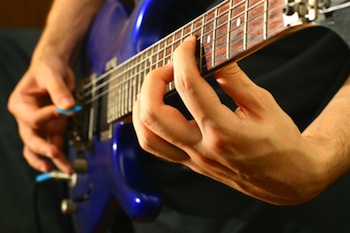Identifying the key makes the task of choosing chords a lot easier, and a lot faster.
Download “The Essential Secrets of Songwriting” 10-eBook Bundle, and find out why good songs become hits, and what you can do to improve the quality of your own songwriting.
 How do you know what the key of a song is, and how important is that anyway? Getting the key right allows you to find the seven chords that will form the majority of the chords you’ll use in the song. It also makes it easier to choose all sorts of interesting “altered chords,” rather than leaving that up to random chord hunting. In short, songs sound better when chords make sense, and that all starts by identifying the key.
How do you know what the key of a song is, and how important is that anyway? Getting the key right allows you to find the seven chords that will form the majority of the chords you’ll use in the song. It also makes it easier to choose all sorts of interesting “altered chords,” rather than leaving that up to random chord hunting. In short, songs sound better when chords make sense, and that all starts by identifying the key.
There are a couple of different ways to identify the key of your song. The easy way, though not necessarily always the most accurate way, is to look at the final note of the chorus, or of the verse if it’s a song without a chorus. It’s often (though not always) the tonic note. But this method may lead you astray. For example, identifying key this way gives us the right answer of G major for the key of Carly Rae Jepsen’s “Call Me Maybe,” which has a chorus melody that ends on G. But that method wouldn’t work for Gotye’s “Somebody That I Used To Know”, which is primarily in D minor, but has a melody that ends on F.
 “Hooks and Riffs: How They Grab Attention, Make Songs Memorable, and Build Your Fan Base” – There’s a lot more to a hook than you probably knew. Learn how to breathe life into a song with just the right kind of hook.
“Hooks and Riffs: How They Grab Attention, Make Songs Memorable, and Build Your Fan Base” – There’s a lot more to a hook than you probably knew. Learn how to breathe life into a song with just the right kind of hook.
The more accurate way requires a bit of music theory knowledge. It can get a little complicated, but here’s the simple version: make a list of all the notes your melody uses, and decide whether or not your song sounds primarily major or minor. The more notes your melody uses, the closer you’ll get to that one key that uses those notes.
Now that you know what key your song is in — let’s say G major, for example — how do you know which chords are the ones that work for that key? Here’s the simple two-step process:
- Write down the notes of the G major scale. If you don’t know how to do that, start on G, and go upward by the following intervals: whole tone, whole tone, semitone, whole tone, whole tone, whole tone, semitone. For G major, that gives you the following notes: G A B C D E F# G.
- Create triads using each note of the G major scale as a root. A triad is a 3-note chord made up of a root, a 3rd and a 5th. And be sure that each note of each triad is one that exists in the G major scale. So you’ll get G-B-D, A-C-E, B-D-F#, C-E-G, D-F#-A, E-G-B, and F#-A-C.
Each chord that you’ve created has a particular quality – major, minor or diminished. So here are the seven chords that belong to the key of G major:
G Am Bm C D Em F#dim
The chord quality is the same no matter what key your in. So if, for example, your song was in Bb major, you’d discover that the seven chords for that key are: Bb Cm Dm Eb F Gm Adim.
For most songs that you write, those seven chords will be all you’ll need. And of those seven, the most commonly used ones (in our example of G major) will be G, Am, C, D and Em. The Bm is used less often, and F#dim is probably the one used least frequently.
And now that you know the key, you can easily choose altered chords that will add interest to your chord progressions. Here are some altered chords to try, along with examples of how to use them. Each altered chord is underlined in the examples:
- Flat-III: G Bb C D G
- Flat-VII: G C D F G
- Minor IV: G D C Cm G
- Major II: G A C D G
- Minor V: G Dm C D7 G
 Written by Gary Ewer. Follow Gary on Twitter
Written by Gary Ewer. Follow Gary on Twitter
 “The Essential Secrets of Songwriting” 10-eBook bundle will show you how to write great songs, harmonize your melodies, and give you hundreds of chord progressions in the process.
“The Essential Secrets of Songwriting” 10-eBook bundle will show you how to write great songs, harmonize your melodies, and give you hundreds of chord progressions in the process.
PURCHASE and DOWNLOAD the e-books for your laptop/desktop, tablet, or any other PDF-viewing device.










I am working on writing a song and the chord progression is for the verse-Am/A/D/Am and the chorus is B/A/D/D/A/D what key would this be in? Also the intro is the same as the chorus there is no lead and the lyrics are just yelling and screaming inaudible obscenities.Thank you
Pingback: Identifying Chords that Work Well Together – ciatawallfcachgi
Pingback: 8 Tips to Guide Your Search for Chord Substitutions | The Essential Secrets of Songwriting
Pingback: Make Improvisation a Smarter Part of Your Songwriting Process – The Essential Secrets of Songwriting
Pingback: Identifying Chords that Work Well Together | The Essential Secrets of Songwriting
My old music teacher wrote a tune…he’d like for me to play around with it…I’m honoured & blessed. Here’s the chords he gave me to try out with this song. Can anyone tell me the key of the song with these chords? The chords are as follows:
INTRO…Am-Dm-C7-F-A7-Dm E7 Am-A+
VERSE…A-Amaj7-A6-A7
D-Dm-Asus4-A
Dm-Asus4-A
BRIDGE/CHORUS/SOLO?????…F-D
F-A7
F-D-Edim-F#dim-E7
REPEAT…VERSE…ETC.
This is what he sent me to play around with. It’s not really necessary to know exactly what key this would be in, but I’d like to know. Thanks for your time.
Pingback: Using Strong Beats to Help Add Chords to a Melody | The Essential Secrets of Songwriting Blog
Pingback: Identifying Chords that Work Well Together | The Essential Secrets of Songwriting Blog
Hey Gary,
Always love reading your posts. The other way of looking at some of the progressions you’ve picked is to explain the all the chords as not alterations to a major scale, but natural to a different mode:
“Flat-III: G Bb C D G” could be explained as G-dorian
“Flat-VII: G C D F G” could be explained as G-mixolydian
Hi Dave:
Thanks very much, and glad you enjoy reading. Regarding those altered chords, you can think of them as a different mode, but only if all the notes of all of the chords in question belong to that mode. So the Flat-III in my first suggested progression can’t really be thought of as G-dorian, because the G chord itself has a B-natural as its 3rd. G-dorian would require it to be a B-flat. The same with the progression that has the Flat-VII… mixolydian mode would require the D chord to be a D minor, since G mixolydian would use F-natural.
Those altered chords are probably better described as modal mixtures, or borrowed chords. The progression is in major, but those altered chords are briefly “borrowed” from the minor side.
Thanks for writing, Dave.
-Gary
Gary, this post has really hit home for me, thanks so much! I have been using the diatonic chords method for a couple of years now and it is immensely helpful, but I often have chords that ‘don’t fit’ and so I would become doubtful about what key I was in … the Flat-III etc altered chords you describe are probably what I have been using (chosen by ear), so now I know what’s going
on!
Thanks very much – I’m glad the post helped.
-G